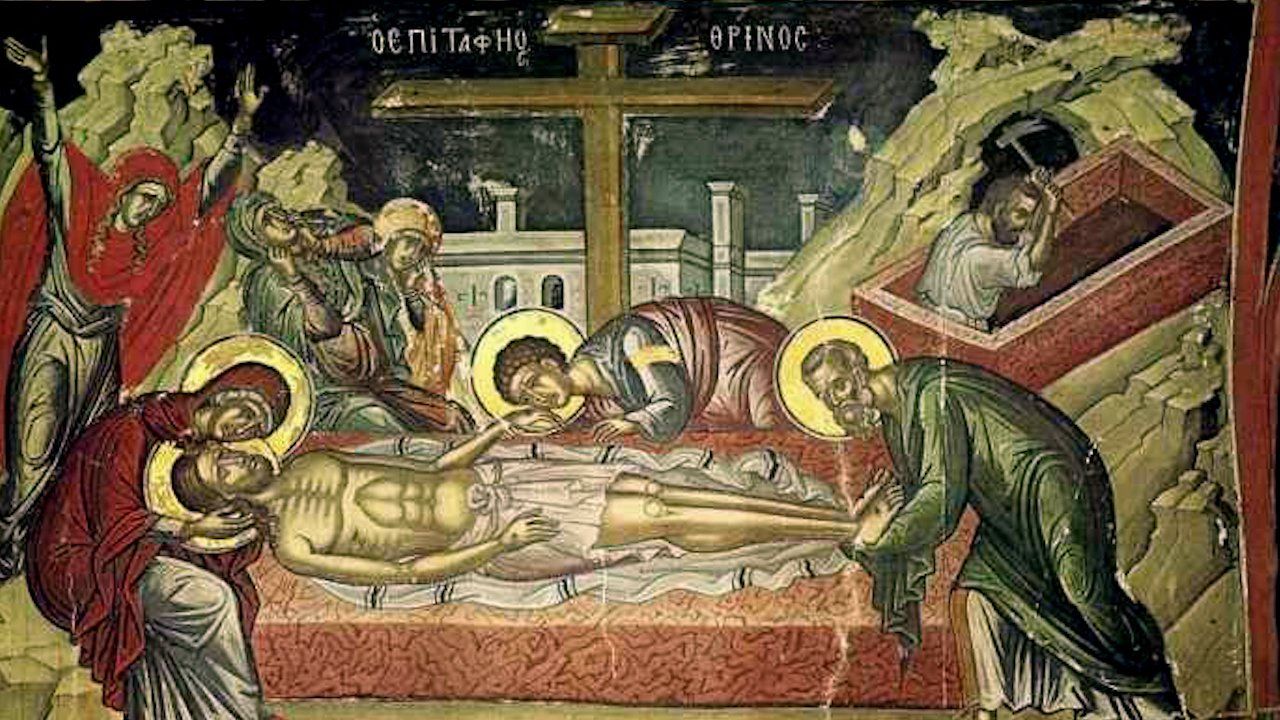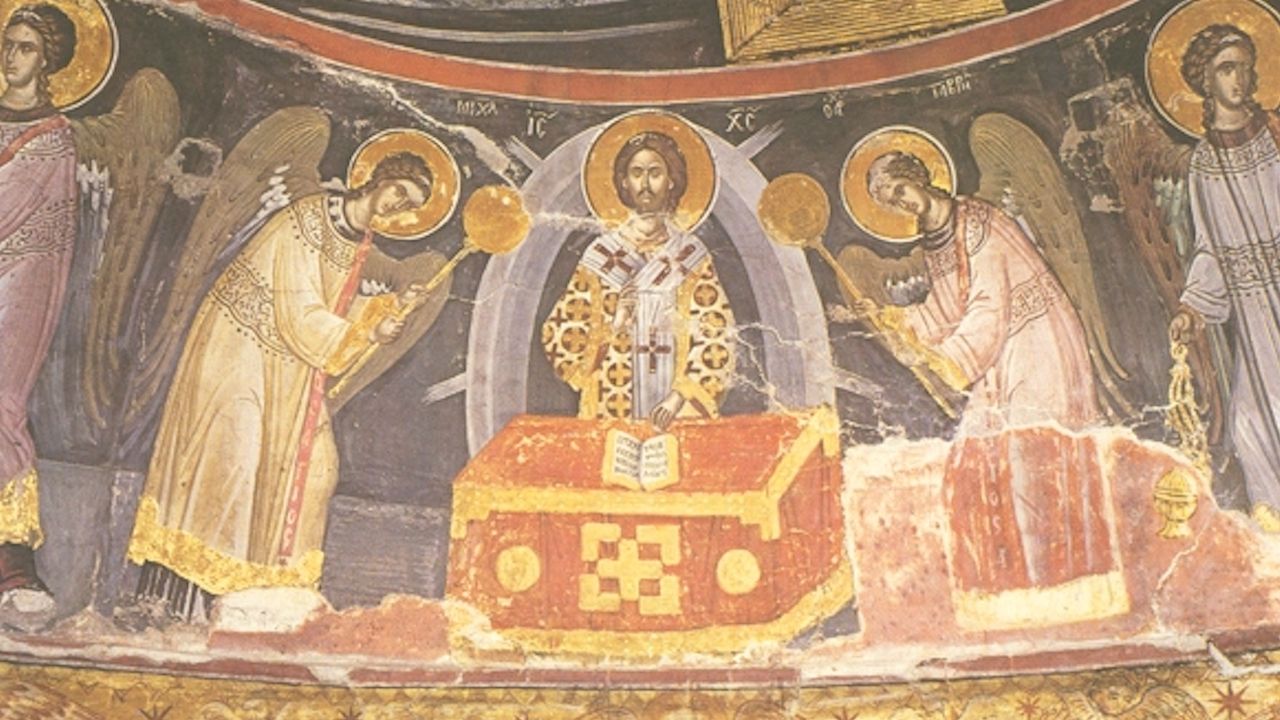1. Essays & Reflections (& Hymnographic Prayers): "Suffering of Jesus in Gethsemane" by Archimandrite Seraphim Bit-Kharibi
Before the cross and His burial, Christ prayed, "My Father, if it is possible, let this cup pass from me; yet, not as I will, but as You will" (Matt. 26:39). For a beautiful, heart-wrenching, hymnographic rendition of that prayer in Arabic – just as Christ would have prayed it –
please take a few minutes to listen to this.
2. Essays & Reflections: "Veneration of the Holy Shroud: The Mystery of Holy Saturday" by Pope Benedict XVI
Pope Benedict XVI has good reason to be fond of Holy Saturday. He was born and baptized on Holy Saturday of 1927. On the fifth Sunday of Easter, 2 May 2010, he made a pilgrimage to the city of Turin to pray before the Shroud of Turin. In his meditation on this pilgrimage, he suggests that the Shroud is the Icon of the mystery of Holy Saturday. He goes on to relate Holy Saturday to our age:
Dear brothers and sisters, in our time, especially after having lived through the past century, humanity has become particularly sensitive to the mystery of Holy Saturday. The concealment of God is part of contemporary man's spirituality, in an existential almost subconscious manner, like a void in the heart that has continued to grow larger and larger. Towards the end of the 19th century, Nietzsche wrote: "God is dead! And we killed him!". This famous saying is clearly taken almost literally from the Christian tradition. We often repeat it in the Way of the Cross, perhaps without being fully aware of what we are saying. After the two World Wars, the lagers and the gulags, Hiroshima and Nagasaki, our epoch has become increasingly a Holy Saturday: this day's darkness challenges all who are wondering about life and it challenges us believers in particular. We too have something to do with this darkness.
But it’s not all darkness. He goes on:
Yet the death of the Son of God, Jesus of Nazareth, has an opposite aspect, totally positive, a source of comfort and hope. And this reminds me of the fact that the Holy Shroud acts as a "photographic' document, with both a "positive" and a "negative". And, in fact, this is really how it is: the darkest mystery of faith is at the same time the most luminous sign of a never-ending hope.
3. Essays & Reflections (& Homilies): "This Is the Blessed Sabbath: Reflections before the Holy Plaschanitsa Icon" by Fr. Sergius Bulgakov
Before turning to this next homily on Holy Saturday, let me first offer a brief explanation of the subtitle to my non-Orthodox brothers and sisters who may be wondering what in the world a "holy plaschanitsa icon" is. Plaschanitsa
is the Slavonic form of the Greek word epitaphios, which is a large embroidered cloth that is used during the services of Holy Friday and Holy Saturday. It depicts Christ’s body after being removed from the cross, lying supine, being prepared for burial, and surrounded by mourners: His mother the Theotokos (bearer/mother of God), His beloved disciple John, Joseph of Arimathea, and Mary Magdalene. This scene from the Gospel of St John 19:38-42 is also commonly depicted in icons. Here’s how Fr. Sergius Bulgakov begins his homily on this icon:
The Lord is in the grave, and we stand at the grave. Once again God is resting from His works and enjoying the rest of the sabbath. Trembling, heaven and earth have bent down to the Lord’s grave. In this solemn quietude, in this audible silence, in this radiant sorrow, our poor soul too contemplates, weeps, prays. People had once murdered the God who came down to earth, and to this day they are ceaselessly murdering Him. In the face of this grave, there is no place for impotent self-defense, for the light of this grave penetrates all the hidden places of the soul and in this light we see our infirmity, wickedness, fallenness.
4. Books: The Feasts of the Lord
by Metropolitan Hierotheos Vlachos of Nafpaktos
5. Poetry: Excerpt from "The Portal of the Mystery of Hope" by Charles Péguy
In the preface to this long poem, Jean Bastaire describes it as a hymn to hope that "sprang forth from the most profound despair." Bastaier continues:
It is not coincidental that such a candid series of pages closes with the night of Good Friday and the burial of Jesus. It ends, however, not in agony, but in the soothing of a mysterious rest, which leaves us as yet uncertain if it will emerge into Easter, even though this is suggested. It is as if the artist’s exhaustion, after his invisible wrestling with the angel, finally reveals itself in his painted signature at the base of the painting.
Here’s an excerpt from that concluding section of the poem:
Night, you remind me of that night.
And I will remember it eternally.
The ninth hour had sounded. It was in the country of my people of Israel.
It was all over. That enormous adventure.
From the sixth hour to the ninth hour there had been a darkness covering the entire countryside.
Everything was finished. Let’s not talk about it anymore. It hurts me to think about it.
My son’s incredible descent among men.
Into their midst.
When you think of what they made of Him.
Those thirty years that He was a carpenter among men.
Those three years that He was a sort of preacher among men.
A priest.
Those three days when He fell victim to men.
Among men.
Those three nights when He was dead in the midst of men.
Dead among the dead.
7. Liturgy: The Lamentations of Matins of Holy and Great Saturday
Every Holy Saturday the Orthodox Church mourns the death of the Son of God with sublime Byzantine hymnography. Although the hymns are later in origin than most Orthodox lenten hymns (dating to the 14th and 15th centuries), they quickly became favorites among Orthodox Christians. If you know your Psalms you’ll recognize the presence of verses from Psalm 119 (118 in Septuagint), which is also used in the Orthodox Church’s funeral service and hence its inclusion here:
Give reward unto Thy servant, quicken me and I will keep Thy words.
He that holdeth all things in the grasp of His hand, in the flesh is now held dead in the depths of the earth, thereby freeing all the dead from Hades’ grasp.
O unveil mine eyes, and I shall perceive wondrous things out of Thy law.
Thou, my Life, O Savior, from corruption didst rise, having died, and therefore dwelling among the dead, and didst shatter the strong bolts of Hades’ hold
I am a sojourner on the earth, hide not from me Thy commandments.
As a lamp of light beneath a bushel is hid, so now also in the earth is God’s flesh concealed, and doth drive away the gloom from Hades’ realm.
8. Word from the Fathers: A Homily on the Burial of the Divine Body of Our Lord and Savior Jesus Christ by St. Epiphanius, Bishop of Cyprus (d. A.D. 403)
Speaking of sublime, this late fourth-century homily is also worthy of that adjective. Here’s a taste:
What thing is this? Today there is great silence upon the earth, great silence and stillness, verily great silence, for the King sleeps. The earth was frightened and became still, for God fell asleep in the flesh and raised up those who from ages past were sleeping. God died in the flesh and Hades shuddered. God slumbered briefly, and those in Hades awoke.
[…]
From Heaven to earth, and from earth to the nether world God makes His way. Ye that from ages past have fallen asleep, rejoice! Ye that sit in darkness and the shadow of death, receive the great Light! With the servants is the Master; with the dead is God; with the mortal is Life; with the guilty is the Guiltless; with those in darkness is the unwaning Light; with the captives is the Liberator; and with those in the nethermost is He that is above the very heavens. Christ came upon earth, and we have believed; Christ is among the dead, let us descend with Him and behold those mysteries yonder! Let us come to know the wonders of the Hidden One hidden under the earth! Let us learn how and to whom the kerygma was manifested in Hades!
**All books (and icons) in print available from Eighth Day Books. Please support an independent bookstore that believes in the eighth day resurrection of our God and Lord and Savior Jesus Christ. Give them a call at 1.800.841.2541 or visit their website here. And don’t forget Eighth Day Members (Patrons+) receive 10% discount, plus many other perks! Learn more and support cultural renewal here.









